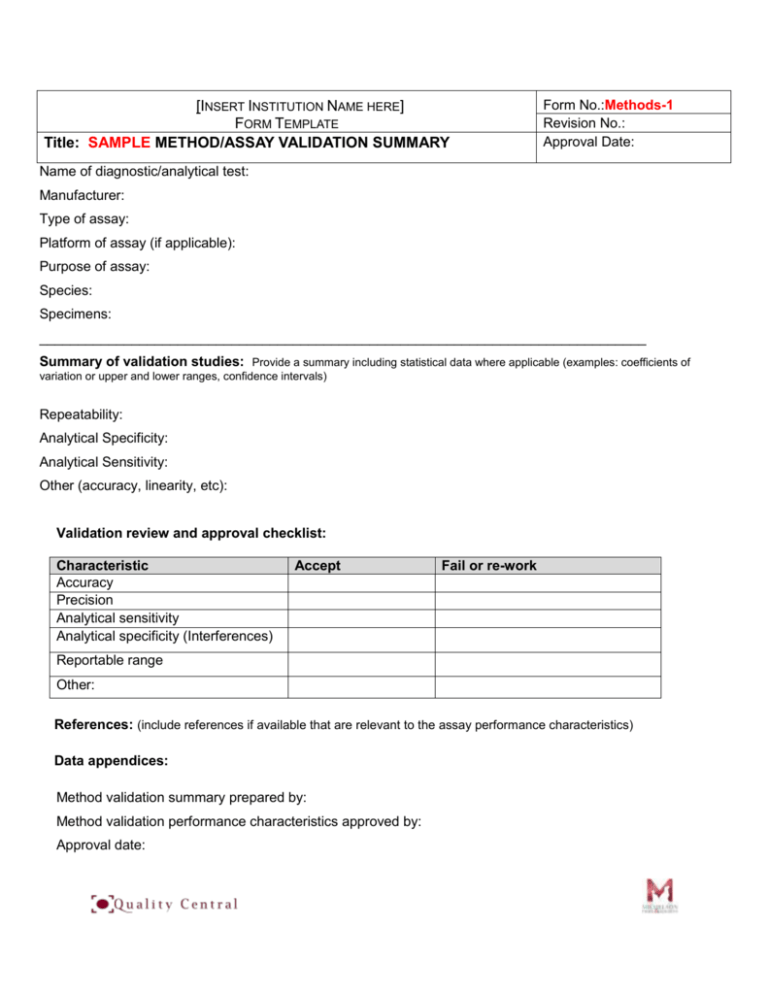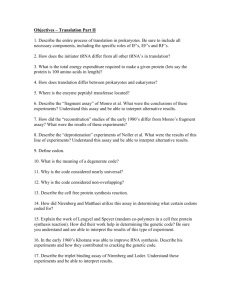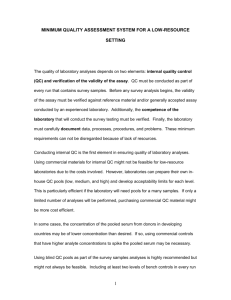Section 3 - Methods Validation Records
advertisement

[INSERT INSTITUTION NAME HERE] FORM TEMPLATE Title: SAMPLE METHOD/ASSAY VALIDATION SUMMARY Form No.:Methods-1 Revision No.: Approval Date: Name of diagnostic/analytical test: Manufacturer: Type of assay: Platform of assay (if applicable): Purpose of assay: Species: Specimens: _______________________________________________________________________________ Summary of validation studies: Provide a summary including statistical data where applicable (examples: coefficients of variation or upper and lower ranges, confidence intervals) Repeatability: Analytical Specificity: Analytical Sensitivity: Other (accuracy, linearity, etc): Validation review and approval checklist: Characteristic Accuracy Precision Analytical sensitivity Analytical specificity (Interferences) Accept Fail or re-work Reportable range Other: References: (include references if available that are relevant to the assay performance characteristics) Data appendices: Method validation summary prepared by: Method validation performance characteristics approved by: Approval date: HOW TO USE THIS TOOL: Maintain a Method/Assay Validation Summary for all assays used in the project. Repeat and record assay validation statistics at regular intervals. Use validation data when interpreting test results (i.e. are test results greater than the documented level of sensitivity? are test result variations greater than coefficients of variation for precision?) WHY DO THIS? Consistent assay validation/performance can prevent measurement errors that impact research findings. These data can be used by auditors to quickly evaluate the researchers’ understanding of assay performance. [INSERT INSTITUTION NAME HERE] FORM TEMPLATE Title: AAVLD TEXT EXAMPLES OF VALIDATION REQUIREMENTS Form No.:Methods-2 Revision No.: Approval Date: Source: American Association of Veterinary Laboratory Diagnosticians, AAVLD Accreditation Committee Guidance Document. 8/27/2008. www.aavld.org . Accessed 1/20/11 Assay Validation Requirements AAVLD Essential Requirements, Version 4.2 Explanation and Examples The Essential Requirements of the AAVLD require that test methods are selected based on the “suitability of the test method, its acceptability by the scientific and regulatory communities, its acceptability to the client, and its feasibility given available laboratory resources” (AAVLD Essential Requirement 5.1.1 and 5.4.1.1). The note appended to the AAVLD Essential Requirements provides examples of selection of methods (AAVLD Essential Requirement 5.4.2) and validation of test methods (AAVLD Essential Requirement 5.4.3). Note: Test methods may be classified as “validated for use” by meeting the following criteria. 1) Ongoing documentation of internal or inter-laboratory performance using known reference standard(s) for the species and/or diagnostic specimen(s) of interest, AND one or more of the following: 2) Endorsed or published by reputable technical organization (e.g.: OIE Manual of Standards for Diagnostic Tests and Vaccines, US Food and Drug Administration’s Bacteriologic Analytic Methods, Bergey's Manual of Determinative Bacteriology, American Society of Microbiology Manual of Clinical Laboratory Immunology, American Association of Avian Pathologists Isolation and Identification of Avian Pathogens, EPA protocols, American Fisheries Society Bluebook, AOAC, NAHLN); 3) Published in a peer-reviewed journal with sufficient documentation to establish diagnostic performance and interpretation of results; 4) Documentation of internal or inter-laboratory comparison to an accepted methodology or protocol. AC-103 V.4.2 08-27-08 Page 1 of 5 Examples to elucidate interpretation of validation requirements Serology Example 1: Mycoplasma gallisepticum HI: Positive and negative serum obtained from a reference laboratory are tested with each run, laboratory documentation is retrievable and indicates that positive serum titer is reproducible +/- one dilution (e.g. expected titer 1:40, laboratory QC accepts assay when control 1:20, 1:40, or 1:80). o Laboratory SOP meets AAVLD Accreditation requirement #1: documentation of internal laboratory performance using a known reference standard(s). Protocol used is published in the American Association of Avian Pathologist Manual and in the National Poultry Improvement Plan Auxiliary Provisions. o Laboratory SOP meets requirement #2: Endorsed or published by a reputable technical organization. Laboratory tested a panel of 10 samples from vaccinated/exposed poultry with 5 other labs, in cooperation with NPIP in 1994 and 1996, to assess inter-laboratory reproducibility. o Laboratory SOP additionally meets requirement #4: documentation of interlaboratory comparison to an accepted methodology as well as documentation of inter-laboratory performance. Example 2: Laboratory has been using IFA to test for “New Dog Virus” since 2000. Protocol was developed using virus isolated from original clinical case, and sera obtained from experimentally inoculated dogs is now used as positive control(s). Laboratory documentation is available to show that the assay positive control routinely gives a titer between 1:100 and 1:1600. During development of the assay, sera obtained from dogs that were diagnosed with the “New Dog Virus” at necropsy (case definition established as positive VI and compatible histopathology) tested positive on the IFA 89% of the time and sera from dogs submitted for necropsy due to unrelated illness tested negative on the IFA 95% of the time. o Laboratory SOP meets requirement #1: documentation of internal laboratory performance using a known reference standard (the positive control sera). Though the reproducibility is not as consistent as one would like, the requirement is only that the laboratory know “how the test performs”, and interprets for the client using that information). o Laboratory meets requirement #4: internal comparison to a reference or gold standard (virus isolation and pathology results used during development of the AC-103 V.4.2 08-27-08 Page 2 of 5 assay). Note: the assay demonstrates both false negative and false positive results; the criteria for validation does not require a specified level of diagnostic accuracy, just that the laboratory be able to provide the client with meaningful interpretation of assay results based on the laboratory’s documentation of how the assay performs. Example 3: Anaplasma marginale cELISA run with sera from elk Positive and negative bovine sera obtained from the company that manufactures and sells the test kit are tested with each run, laboratory documentation is retrievable and indicates that percentage inhibition with each sera meets the QC standard. Positive and negative elk sera were obtained from a research laboratory experimentally infecting elk and deer, are run with each assay for which elk samples are tested, and laboratory documentation is available. o Laboratory SOP meets AAVLD Accreditation requirement #1: documentation of internal laboratory performance using known reference standard(s). Protocol for testing bovine sera is published in the Journal of Veterinary Diagnostic Investigation and is validated for bovine sera through the licensing process with the USDA Center for Veterinary Biologics. No reference is available for elk sera. o Laboratory SOP for testing elk sera does not meet requirements #2 or #3: Endorsed or published by a reputable technical organization, or published in a peer-reviewed journal with sufficient documentation to establish diagnostic performance and interpretation of results . Laboratory does not have a panel of reference elk sera to assess the performance of the assay, and no inter-laboratory comparison is available. o Laboratory SOP does not meet requirement #4: documentation of interlaboratory comparison to an accepted methodology as well as documentation of interlaboratory performance. In this case, the assay can be run and results reported. However, an explanatory note that “this assay is validated for use with bovine sera only and is undergoing validation with elk sera” must accompany the result. Virology Example 1: Antisera based identification of Equine Rhinopneumonitis Virus in cell culture. The laboratory SOP for virus identification in cell culture is to perform FA using polyclonal antisera specific for EHV. The laboratory’s positive control serum AC-103 V.4.2 08-27-08 Page 3 of 5 was obtained from a clinical case 10 years prior. The laboratory has reference viruses (EHV, Equine arteritis virus, Equine Influenza) obtained from ATCC that are used “periodically” to check the cell lines. The ATCC EHV reference virus consistently tests positive using the EHV clinical control sera, while the other viruses give negative reactions. o Laboratory SOP meets requirement #1: documentation of internal laboratory performance using a known reference standard (positive control). The VI protocol used is referenced to “Manual of Standardized Methods for Veterinary Microbiology,” Cottral, and the OIE Manual. Since the laboratory has substituted polyclonal antisera obtained from a reference laboratory for a positive clinical sample they must provide the documentation that they have tested the clinical sera against other equine viruses (e.g. equine arteritis virus, influenza virus, EEE virus, etc. as applicable to their laboratory) to ensure no crossreactions. o Laboratory SOP meets requirement # 2: Endorsed or published by a reputable technical organization. Bacteriology Example 1: Identification of Moraxella bovis from conjunctival swab The laboratory SOP for bacterial isolation specifies that blood agar and McConkey agar plates are used for aerobic culture procedure. Predominant colonies are isolated and tested for biochemical characteristics to identify the genus and species of the bacterium. Laboratory maintains records of performance of all media used for lab testing, whether produced in-house or bought from a commercial source, and wherever necessary uses a stock of different bacteria (known reference standards), according to acceptable standards (e.g. CLSI), to perform assurance testing of media used for culturing and identification. Laboratory also documents participation and performance in the inter-laboratory comparisons and or proficiency tests. Documentation of these QC procedures is available in the lab. o Laboratory SOP meets requirement #1: documentation of internal and or interlaboratory performance using a known reference standard or a benchmark. The SOP references Bergey's Manual of Determinative Bacteriology and the US Food and Drug Administration’s Bacteriologic Analytic Methods. Laboratory SOP meets requirement # 2: Endorsed or published by a reputable technical organization. Immunohistochemistry Example 1: Laboratory is using immunohistochemistry to detect canine and feline parvovirus in tissue sections. AC-103 V.4.2 08-27-08 Page 4 of 5 Protocol was developed using a commercially available monoclonal antibody and sections from diagnostic laboratory caseload – 13 canine and 14 feline accessions - as reference standards. Case definition for reference standards was compatible histopathology (crypt necrosis and drop out) and electron microscopy identifying parvoviral particles. Negative cases (5 feline and 5 canine) were identified using histopathology and lack of any clinical signs compatible with parvoviral enteritis. All IHC control and case results are documented and deviations from expected results noted. For the parvoviral assay, only one unexpected result out of 26 assays run in the past year has been recorded. In that case, a negative parvoviral IHC was present in a dog with a positive parvoviral EM result. o Laboratory SOP meets requirement #1: documentation of internal laboratory performance using a known reference standard (the positive and negative control sera and case accessions)). o Laboratory meets requirement #4: internal comparison to a reference or gold standard (virus identification by EM and pathology results used during development of the assay). AC-103 V.4.2 08-27-08 Page 5 of 5



